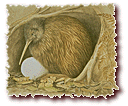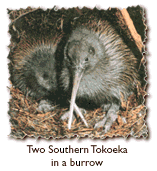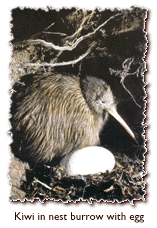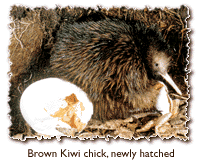

 |
Kiwi usually keep the same partners for life. They use their burrows as nests. The burrow is usually lined with an
untidy pile of soft leaves, grass and moss. When they are inside,
the kiwi often pull leaves and sticks across the entrance to
hide it and to keep the burrow warm. |
 |
One bird in a pair sits on the egg almost all the time they are developing. This is called 'incubating' the egg and takes about two and a half months. Usually it is the male bird which incubates the eggs, but in some species it is the female. The male kiwi develops a bare patch of skin on his belly, known as a brood patch. It is used to keep the egg warm during incubation. Occasionally a young bird will share the incubation too. Early in incubation the adult may leave the egg alone for some hours while they feed. But when it is close to hatching the adult will stay with the egg for three or four days without leaving the nest. |
|
It takes about three days for a chick to hatch. At first the egg just jiggles around slightly, then may stay still for 20 minutes, then jiggle again. After a long time the chick makes a little hole in the end of the egg. Then it pokes the tip of its beak through the hole and begins to breathe air. It usually has a long sleep after that - from 12 to 48 hours. When it wakes up again it begins to push against the wall of the shell with its big feet until it makes a crack and can break the shell open. It takes a long time until it can struggle out of the shell. Most chicks have fluffy down feathers when they hatch, but kiwi chicks already have their proper feathers. |
 |
Chicks may not eat for several days - they are still using up the yolk of the egg which is in their stomach. When they do go out for food, they first eat small stones. These will stay in their stomachs and will help to grind up their food. After a few more days the chick will start to eat the same food as the adult kiwi. They can't push their beaks into the ground yet though, because they are quite soft at first. During the first three or four weeks the chick feeds at night and during the day. Many chicks are killed by stoats and cats while they are very young. |